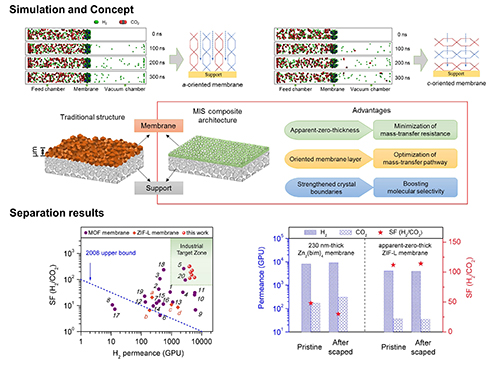Zeolitic Imidazolate Framework-L Membrane Improves Separation Efficiency of H2/CO2
Metal-organic framework (MOF) membranes are promising for energy-efficient chemical separations. However, the microstructural design of these membranes remains challenging.
Recently, a research group led by Prof. YANG Weishen and Dr. BAN Yujie from the Dalian Institute of Chemical Physics (DICP) of the Chinese Academy of Sciences proposed a zeolitic imidazolate framework (ZIF)-L membrane with a membrane-interlocked-support composite architecture for H2/CO2 separation.
The study was published in Science Bulletin on May 12.

Microstructural design of ZIF-L membranes (Image by BAN Yujie and YANG Kun)
The researchers completely confined the ZIF-L membrane into the voids of the alumina support through an interfacial assembly process, yielding membrane-interlocked-support (MIS) composite architecture. It presented apparent-zero-thickness, oriented membrane layer and strengthened crystal boundaries, which contributed to high permeance and high selectivity.
The membranes showed average H2 permeances of above 4000 GPU and H2/CO2 separation factor (SF) of above 200, falling into the industrial target zone.
Furthermore, the ZIF-L membrane showed mechanical stability, scraped repeatedly by a piece of silicon rubber causing no selectivity loss.
Previously, the group collaborated with Prof. LI Weixue from University of Science and Technology of China to identify the anisotropic mass transfer rate through the two kinds of channels of ZIF-L by means of molecular dynamics simulations, providing preliminary guidance for this study.(Text by BAN Yujie and YANG Kun)